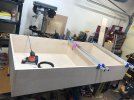Alright, the attached photo is of a bookshelf I am making for my daughter for her birthday. It is 40" x 80" and the body is made out of 3/4" maple. The maple plywood was only a $1 more per sheet than the other stuff.
With it being maple, I am trying to decide on the best way to add facing and shelves (which will be adjustable). Cost is a variable as well combined with my daughter wants me to stain it the same color as a desk I make her.
SO, should I try and face it off and make shelves out of maple or is there another wood that would match well at a lower cost? That question is mainly because it will be stained. I will have to go up to Raleigh (in Fayetteville) at this point to find dry maple in the size I need because the height of the side faces will be over 70" and the shelf width will be 13-14" (cannot recall exactly off the top of my head). I anticipate that the shelves will have to be laminated to get desired width. Plus the cost is a concern combined with time to get up to Raleigh during the limited store hours of places like Woodcraft or Klingspore's.
So yeah, advice is welcome and appreciated.
With it being maple, I am trying to decide on the best way to add facing and shelves (which will be adjustable). Cost is a variable as well combined with my daughter wants me to stain it the same color as a desk I make her.
SO, should I try and face it off and make shelves out of maple or is there another wood that would match well at a lower cost? That question is mainly because it will be stained. I will have to go up to Raleigh (in Fayetteville) at this point to find dry maple in the size I need because the height of the side faces will be over 70" and the shelf width will be 13-14" (cannot recall exactly off the top of my head). I anticipate that the shelves will have to be laminated to get desired width. Plus the cost is a concern combined with time to get up to Raleigh during the limited store hours of places like Woodcraft or Klingspore's.
So yeah, advice is welcome and appreciated.

